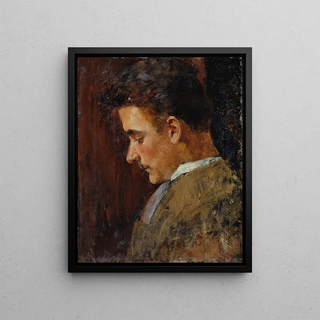Art print | Portrait of youth by Rudolf Steindl, brother-in-law of the artist - Koloman Moser


View from behind

Frame (optional)
Portrait of Rudolf Steindl, brother-in-law of the artist - Koloman Moser – Captivating introduction
In the expansive panorama of early 20th-century Viennese art, the "Portrait of Rudolf Steindl, brother-in-law of the artist - Koloman Moser" stands out for its elegance and emotional depth. This artwork, which showcases not only Moser's technical talent but also his keen sense of composition, immerses us in the intimacy of a moment frozen in time. The subject's gaze, tinged with melancholy and reflection, evokes a rich and complex personal story, while also fitting into a vibrant artistic context. It is an invitation to explore the nuances of the human soul through the lens of art.
Style and uniqueness of the work
Koloman Moser's style is undeniably influenced by the Vienna Secession movement, which advocates a break from academic conventions. In this portrait, Moser skillfully combines elements of realism with a decorative approach, creating a piece that transcends a simple portrait to become a true artistic statement. The colors, carefully selected, range between soft tones and striking contrasts, highlighting Rudolf Steindl's facial features. The light, omnipresent, sculpts the forms and emphasizes details, while the background, subtly worked, enhances the sense of depth. Every element of the composition is designed to serve the expression of the subject, revealing Moser's mastery in capturing the human essence.
The artist and his influence
Koloman Moser, a prominent figure of Austrian art, made his mark by adopting an innovative approach that merges art and design. As a founding member of the Vienna Secession, he contributed to the emergence of a new artistic language that aimed to be both modern and accessible. Moser does not merely paint; he creates worlds where art integrates into everyday life, influencing generations of artists. His work on the portrait of Rudolf Steindl perfectly illustrates this desire to transcend traditional boundaries, while also reflecting the intimacy of human relationships. Moser, through his distinctive style

Matte finish

View from behind

Frame (optional)
Portrait of Rudolf Steindl, brother-in-law of the artist - Koloman Moser – Captivating introduction
In the expansive panorama of early 20th-century Viennese art, the "Portrait of Rudolf Steindl, brother-in-law of the artist - Koloman Moser" stands out for its elegance and emotional depth. This artwork, which showcases not only Moser's technical talent but also his keen sense of composition, immerses us in the intimacy of a moment frozen in time. The subject's gaze, tinged with melancholy and reflection, evokes a rich and complex personal story, while also fitting into a vibrant artistic context. It is an invitation to explore the nuances of the human soul through the lens of art.
Style and uniqueness of the work
Koloman Moser's style is undeniably influenced by the Vienna Secession movement, which advocates a break from academic conventions. In this portrait, Moser skillfully combines elements of realism with a decorative approach, creating a piece that transcends a simple portrait to become a true artistic statement. The colors, carefully selected, range between soft tones and striking contrasts, highlighting Rudolf Steindl's facial features. The light, omnipresent, sculpts the forms and emphasizes details, while the background, subtly worked, enhances the sense of depth. Every element of the composition is designed to serve the expression of the subject, revealing Moser's mastery in capturing the human essence.
The artist and his influence
Koloman Moser, a prominent figure of Austrian art, made his mark by adopting an innovative approach that merges art and design. As a founding member of the Vienna Secession, he contributed to the emergence of a new artistic language that aimed to be both modern and accessible. Moser does not merely paint; he creates worlds where art integrates into everyday life, influencing generations of artists. His work on the portrait of Rudolf Steindl perfectly illustrates this desire to transcend traditional boundaries, while also reflecting the intimacy of human relationships. Moser, through his distinctive style






